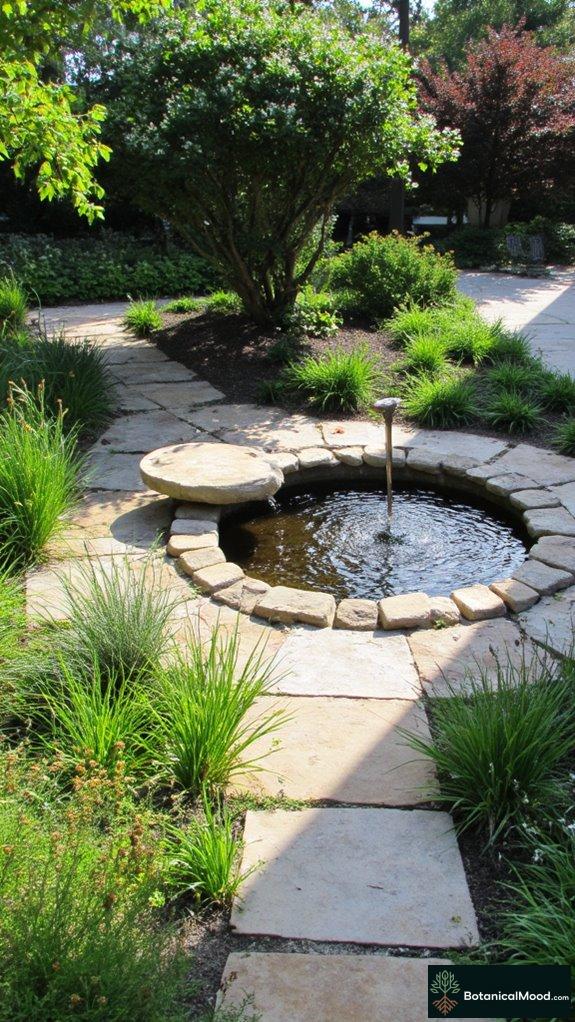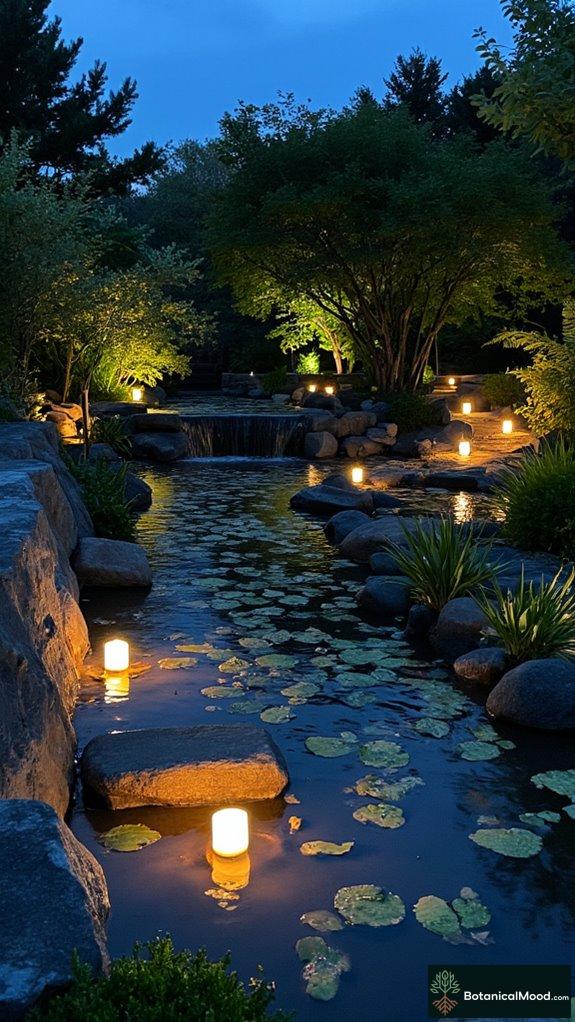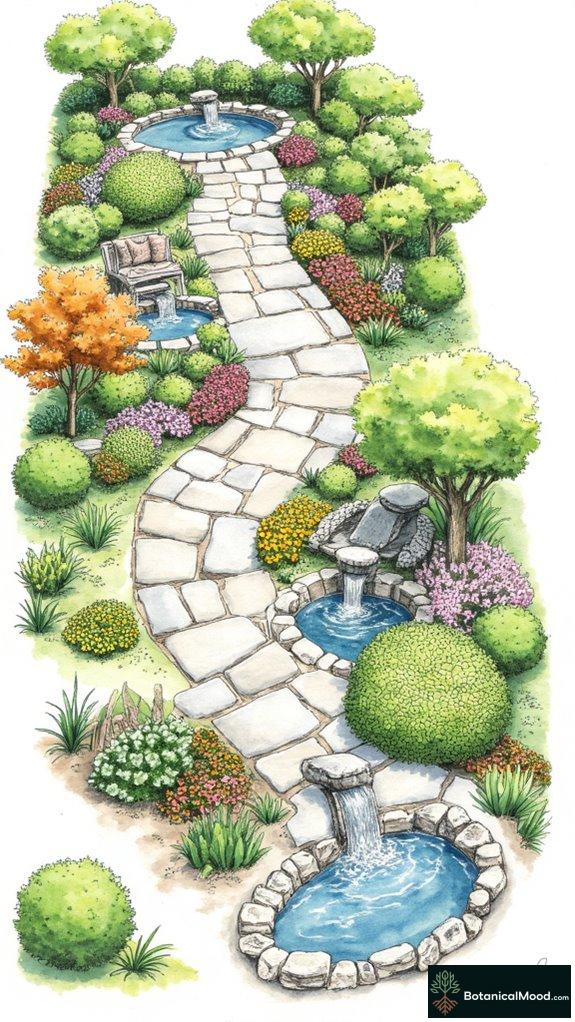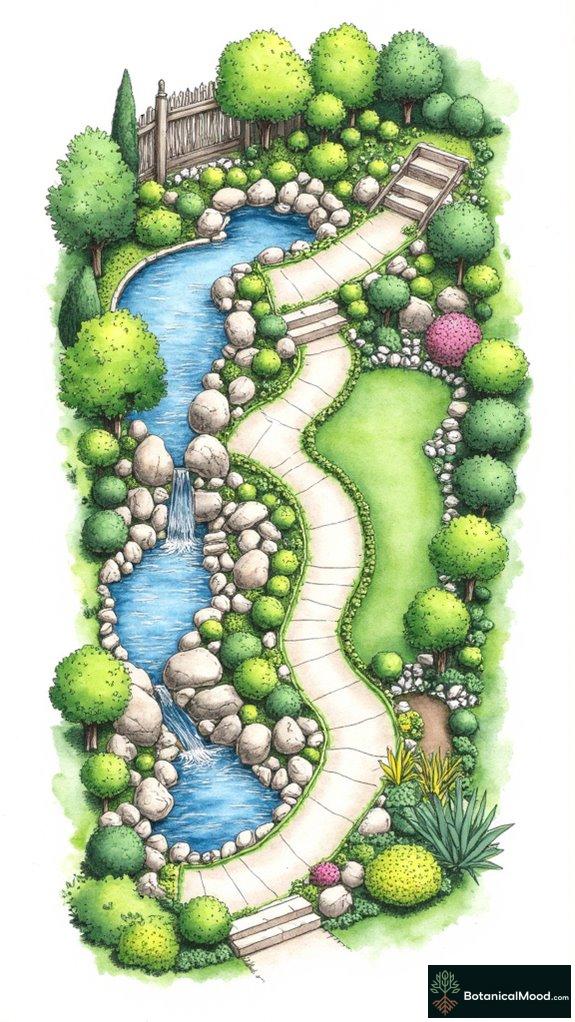Ever tried creating a water garden in the middle of a concrete jungle? Talk about ambitious!
I once thought I could transform my tiny urban balcony into a tranquil oasis. Spoiler alert: it was a chaotic mess of floating plant life, wildly ambitious dreams, and mosquitoes auditioning for a horror film.
But when I finally added some rock-solid American Waterweed and those eye-catching Cattails, it felt like I’d cracked the code to serenity. Who knew a little splash could attract wildlife and avert stormwater drama?
Isn’t it amazing how nature throws a party, even in our cluttered lives?
Designing Your Urban Oasis: A Personal Journey
A few summers ago, I decided to give my tiny, concrete-laden yard a makeover. Armed with nothing but enthusiasm and a questionable Pinterest board, I dove into the world of garden design. I combined simple bamboo frames with eco-friendly materials, which felt like crafting a classy cocktail from random leftovers.
Unexpectedly, a small pond emerged, drawing frogs who seemed like they were auditioning for “America’s Got Talent”. And you know what? That little patch actually brightened up the whole block, proving that even the smallest spaces can make a significant impact.
So, if you find yourself daydreaming about a beautiful water garden or just want to channel your inner Zen master, remember: every drop counts!
Quick Takeaways
- Water gardens enhance urban aesthetics while providing ecological benefits like stormwater management and biodiversity support.
- Integrating balanced water features with harmonious materials complements the existing landscape and architecture.
- Selecting diverse aquatic plants increases both beauty and ecosystem health, offering habitats for wildlife.
- Utilizing sustainable materials and practices, like recycled elements and permeable surfaces, promotes eco-friendliness and reduces environmental impact.
- Thoughtful lighting can create an enchanting atmosphere, transforming water features into captivating focal points, especially at night.
The Allure of Water Gardens in Urban Landscapes

Water gardens captivate our senses and enrich urban environments in ways that go beyond mere aesthetics. Their aesthetic charm, combined with profound water health benefits, creates vibrant spaces that invite both reflection and interaction. By facilitating stormwater management, these gardens mitigate flooding and enhance groundwater replenishment, showcasing their crucial environmental impact. Moreover, they play an essential part in supporting biodiversity benefits, offering wildlife habitats for pollinators and aquatic organisms that are fundamental to ecological integrity. As these gardens often incorporate innovative features like sleek steel designs, they not only enhance the visual appeal but also create dynamic interactive experiences for visitors. Community engagement blossoms as individuals bond over shared stewardship, cultivating a sense of identity and cultural significance. Inspired by the potential of urban water gardens, I created Botanical Mood to celebrate innovative designs that harmonize nature and community, aligning sustainability with beauty for a better urban future.
Designing With Balance: Integrating Water Features

Creating a harmonious environment often requires thoughtful consideration of water features, which can transform any space into a serene oasis.
Using balance techniques in design is essential; proportionate sizing of fountains or ponds guarantees they complement rather than detract from surrounding elements. For instance, a large fountain can overwhelm a compact garden, while a tiny water feature can get lost in expansive environments.
Achieving feature harmony entails matching materials and styles with existing architecture, fostering unity throughout the design. Incorporating small backyard fountains can offer a perfect solution for limited spaces, adding charm without overwhelming the scene.
Carefully contemplating placement not only enhances visual balance but also encourages safe circulation, drawing visitors to relax in your beautifully integrated garden.
Choosing the Right Water Plants for Your Garden

When designing a tranquil garden space, selecting the right water plants can considerably enhance the overall aesthetic and health of your aquatic ecosystem.
Here are some key plant selections to reflect upon:
- Submersible plants like American Waterweed thrive underwater, offering oxygenation and thrive in full sun.
- Floating plants such as water stargrass create floating colonies, serving as habitat for microinvertebrates in shallow water.
- Marginal plants like Sweet Flag grow at edges, adapting well to partial shade to full sun.
- Emergent plants such as Cattails flourish in moist soil and provide essential stability along water bodies.
Innovative Materials for Sustainable Water Features

Incorporating innovative materials into sustainable water features not only enhances the beauty of your garden but also promotes environmental stewardship. By choosing natural stones like granite and limestone, I guarantee durability while these materials seamlessly blend into the environment, reducing environmental impact.
Using recycled materials, such as reclaimed wood and recycled glass, supports sustainable practices, contributing to a circular economy that minimizes resource consumption.
Plus, opting for locally sourced materials lowers our carbon footprint.
Integrating permeable surfaces, like gravel, enhances water absorption and minimizes erosion, fostering eco-friendly design.
With every decision, I endeavor to create an inviting oasis that showcases nature’s beauty while adhering to sustainable techniques. This commitment to thoughtful design reflects my passion, which inspired me to create Botanical Mood.
Creating Ambiance: Lighting Solutions for Water Gardens

Lighting solutions can transform any water garden into an enchanting nighttime retreat that showcases its beauty and tranquility.
Transform your water garden into a mesmerizing nighttime oasis that highlights its serene beauty and charm.
Emphasizing the right light color and innovative energy sources can truly elevate the space.
Here are four lighting options to contemplate:
- Underwater lights highlight aquatic plants and water movement, creating an alluring depth.
- Floating lights scatter around the pond’s surface, reflecting enchanting shimmering patterns.
- Spotlights strategically placed on waterfalls or fountains dramatize their beauty, drawing the eye.
- Pathway lighting guarantees safety, guiding visitors while enhancing the garden’s overall aesthetic.
Essential Maintenance Tips for a Thriving Water Garden

Maintaining a vibrant water garden isn’t just about planting beautiful flora; it’s an ongoing commitment that guarantees your aquatic paradise thrives.
Regular maintenance is key to guaranteeing pond health and overall aesthetic appeal. I make it a habit to remove leaves and plant waste using a fishing net, especially in autumn, to avoid water quality degradation.
Monitoring water parameters like pH and ammonia keeps the environment balanced. I also trim back overgrown aquatic plants to promote oxygenation and reduce overcrowding.
Investing time in cleaning and inspecting equipment is advisable; it prolongs lifespan and enhances functionality.
Water Feature Spatial Arrangement

As I create my water garden, understanding spatial arrangement becomes fundamental, especially since it serves an important function in harmonizing each element within this aquatic oasis.
I lean towards using certain principles to guarantee a fascinating experience:
- Emphasize negative space to create visual breathing room, allowing water features to stand out.
- Employ asymmetrical balance to reflect nature’s organic beauty, avoiding rigid, predictable designs.
- Opt for odd-numbered groupings of stones and plants for a naturally pleasing composition.
- Design functional zones that clearly separate active and contemplative spaces, improving overall flow.
Water Feature Positioning Strategies

Positioning your water features thoughtfully not only enhances their aesthetic appeal but also elevates the overall harmony of your garden. I advise you to reflect on water feature height and seasonal positioning for peak impact.
For instance, elevated fountains can create striking visuals and maintain accessibility for children, while lower ponds nestled within natural slopes enhance organic flow and integrate seamlessly.
Be mindful of sunlight exposure; full sun will benefit flowering aquatic plants, whereas partial shade can control algae growth.
To maximize enjoyment, place water features near outdoor seating or windows for year-round visibility.
Strategically positioning your water elements won’t only captivate your guests but also enrich your garden’s uniqueness, which is the very essence of what I envisioned when creating Botanical Mood.
Cohesive Flow in Water Features

Creating a seamless flow in your garden’s water features requires both thoughtful design and practical integration, especially if you want to achieve an enchanting atmosphere that captivates visitors.
To guarantee effective feature synchronization and harmonious water flow, consider these key elements:
- Design Cohesion: Match materials of your water features with existing environment elements to promote visual unity.
- Ecological Balance: Incorporate plants that thrive in the unique micro-environment around the water feature, supporting ecosystem health.
- Sound and Movement: Use the soothing sounds of flowing water to guide pathways and create natural changes between spaces.
- Proportional Placement: Verify each water element complements surrounding plants and structures, fostering a balanced aesthetic.
Contemporary Water Feature Layout

While initiating the journey of contemporary water feature layout, you’ll find that thoughtful arrangement considerably enhances the overall garden experience. Water feature zoning plays a critical role in creating functional spaces, guiding interaction with installations that engage and mesmerize.
By carefully considering placement, materials, and technology integration, you can achieve compelling designs. Here’s a quick overview:
| Key Element | Considerations | Benefits |
|---|---|---|
| Material Choice | Natural vs. manufactured | Visual and tactile contrast |
| Light Integration | LED and smart controls | Enhanced aesthetics |
| Water Flow Design | Cascading vs. jet streams | Sound and ambiance |
| Site Placement | Strategic positioning | Accessibility |
| Environmental Compliance | Sustainable practices | Eco-friendly landscaping |
This layout approach, alongside careful material selection and smart technology, captures beauty and innovation, culminating in an enchanting water garden environment.
Garden Shape Considerations

When you start to think about the shape of a garden, the design choices you make can greatly influence the overall aesthetic and functionality of your outdoor space.
Consider these aspects when determining your pond shape:
- Garden Size: Larger spaces embrace complex shapes like kidney or crescent, while smaller areas favor simplicity with circles or rectangles.
- Aesthetic Harmony: Formal gardens shine with symmetrical forms, whereas naturalistic designs revel in curves.
- Wildlife Demand: Irregular edges promote diverse ecosystems, enhancing your garden’s vibrancy.
- Ease of Maintenance: Simpler shapes often simplify upkeep, ensuring your garden remains an inviting sanctuary.
Ultimately, the right pond shape elevates your garden design, harmonizing beauty with functionality.
At Botanical Mood, I endeavor to inspire innovative approaches to create stunning outdoor environments.
Questions and Answers
What Is the Average Cost of Installing a Water Garden?
The average cost of installing a water garden is around $7,400, but your installation budget can vary greatly.
For example, DIY kits range from $500 to $1,300, while professional installations can reach $14,500 or more depending on features.
Furthermore, maintenance costs like fountain upkeep or aquatic plants should also be factored in.
I created Botanical Mood to share ideas about the beauty and design of innovative gardens like these.
How Do I Prevent Mosquitoes in My Water Garden?
To keep mosquitoes away from my water garden, I guarantee constant water circulation with a charming fountain, creating gentle ripples that deter egg-laying.
I also plant lovely mosquito repellents like lavender and mint, which add delightful aromas and enhance the garden’s beauty.
Regularly replacing water helps interrupt their life cycle, while removing standing water and trimming long grasses minimizes resting spots for adult mosquitoes, making my serene oasis enjoyable and pest-free.
Can Water Gardens Attract Wildlife Safely?
Absolutely, water gardens can attract wildlife safely!
By incorporating diverse native plants and providing natural cover, I create thriving habitats that foster wildlife diversity. Designing with gradual edges and varied vegetation enhances accessibility for creatures like frogs, birds, and beneficial insects, while also offering refuge from predators.
As I built my own garden through Botanical Mood, I’ve witnessed firsthand how these vibrant ecosystems contribute to the beauty of our surroundings while supporting local wildlife.
Are Water Gardens Suitable for Small Urban Spaces?
Water gardens are perfect for small urban spaces.
I love how space optimization techniques, like using container gardens that stack plants vertically, create lush greenery even in tight corners.
With careful design techniques, I can incorporate elements that blend with existing architecture, providing both beauty and ecological benefits.
These small oases enhance my surroundings while offering habitats for wildlife, making every inch of my space feel like a vibrant retreat.
What Permits Are Required for Water Features in Urban Areas?
When planning a water feature, you’ll need various water permits to meet urban regulations.
For features like ponds or fountains, building and possibly electrical or plumbing permits are essential. If your design exceeds a certain size or depth, safety barriers and inspections will also be required.
I appreciate the beauty and design of such elements and started Botanical Mood to help you navigate these regulations while creating innovative spaces that inspire tranquility.
References
- https://prism.sustainability-directory.com/scenario/community-gardens-and-water-resource-management/
- https://www.frontiersin.org/journals/sustainable-food-systems/articles/10.3389/fsufs.2018.00071/full
- https://edis.ifas.ufl.edu/publication/FR477
- https://aggie-horticulture.tamu.edu/earthkind/drought/efficient-use-of-water-in-the-garden-and-landscape/
- https://news.umich.edu/study-finds-that-urban-agriculture-must-be-carefully-planned-to-have-climate-benefits/
- https://thelandscapelibrary.com/key-architectural-principles-to-consider-when-designing-water-features/
- https://www.hightechlandscapes.com/designing-the-perfect-water-feature-for-your-landscape-key-elements-to-keep-in-mind/
- https://www.leesgenerallandscaping.com/blog/water-features-and-ponds/
- https://www.californiaext.com/integrating-water-features-into-landscape-design
- https://hiltonlandscapesupply.com/backyard-water-feature/

Leave a Reply